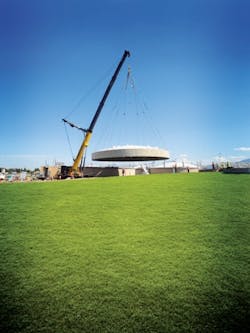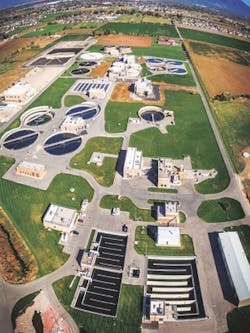Upgrade in Utah
About the author: Brandon Heidelberger, P.E., is principal engineer for Brown and Caldwell. Heidelberger can be reached at [email protected] or 801.316.9805.
As one of the fastest-growing states in America, Utah is on track to double its population by 2050. For utility managers, this means struggling to keep up by providing facilities that can sustain growth and comply with ever-evolving environmental regulations.
About 30 miles northwest of Salt Lake City in Syracuse, Utah, the North Davis Sewer District (NDSD) provides services to 215,000 people in seven communities, including Hill Air Force Base. NDSD owns and operates approximately 100 miles of sewer collection lines, which deliver wastewater to its treatment facility near the shoreline of the Great Salt Lake. This facility has the capacity to treat 34 mgd of wastewater, removing more than 95% of pollutants before releasing the treated water back into the environment of the Great Salt Lake.
With a service population projected to increase by more than 36% over the next 25 years, and with insufficient biosolids treatment processes and outdated technology hampering overall efficiency, NDSD needed to expand and improve its service capacity.
The answer came in the form of a $58 million capital improvement, progressive design-build project that would result in new, energy- efficient facilities designed and built to meet 20 years of future needs. In addition to upgrading the facilities to accommodate growth, NDSD needed to anticipate and comply with current and future environmental regulations. Flexible designs allow the facility to comply with increasingly stringent regulations while embracing sustainability and lowering the facility’s overall carbon footprint.
Between 2002 and 2007, NDSD expanded and improved the liquid portion of its wastewater treatment facility to handle projected future flows and pollutant loadings. But biosolids capacity still needed to be addressed, so NDSD ordered a study to evaluate opportunities for biosolids treatment process expansion and better biosolids disposal/beneficial use.
This assessment, completed in 2010 by the environmental firm Brown and Caldwell, indicated that several biosolids treatment processes were over or at capacity and needed to be expanded and improved to handle current and projected solids loading to the facility. To address these capacity issues, alternatives were evaluated based on technical merits and cost efficiency, so NDSD could determine how best to improve its system to handle the projected future solids production.
Ultimately, the goals boiled down to NDSD’s need to ensure capacity to reliably and safely treat future solids loads; provide a robust biosolids process using proven technology; reduce odors; improve air quality; increase overall efficiency; and meet current and future regulatory requirements.
To meet these goals without going over budget, NDSD worked collaboratively with Brown and Caldwell through an integrated project delivery model to identify technical and delivery innovations and leverage technologies to maximize the use of existing equipment, processes and facilities. The recommended biosolids process improvements were broken into three phases over a five-year period to effectively manage cash flow and maximize local involvement. The design-build project was completed in June 2016.
The Project Commences
The first phase of the project entailed upgrading the secondary digesters to increase the digestion process capacity and bring the plant into compliance with state and federal regulations. This included the installation of four internal draft tube mixers in each of the secondary digesters that mix and heat the sludge as it circulates through the tube. In addition, the lids were removed, coated and insulated to allow the digesters to sustain necessary temperature conditions with minimal energy demand. Rehabilitation of the existing digester tanks and floating covers prolonged the lifespan and beneficial use of the 60-year-old concrete structures and covers, saving NDSD more than $1 million in replacement costs.
The second phase included the construction of a new, 15,000-sq-ft primary sludge thickening building, which improves capacity by removing excess water and eliminates the need for two planned digesters, saving NDSD about $22 million.
When evaluating its solids thickening solution in collaboration with NDSD, Brown and Caldwell compared its thickening design’s cost to the cost of constructing additional digesters, determining that it could achieve the desired solids retention time with a total of six (four existing and two new) digesters instead of eight.
The new primary solids thickening building houses rotary drum thickeners that remove water from the primary sludge prior to digestion, simultaneously reducing the process heating requirements, beneficially increasing digester solids retention time, and increasing digester capacity—making NDSD better prepared to process the projected 40% increase in sludge flow volume anticipated over the next 25 years.
In phase three, NDSD’s commitment to reduce the plant’s reliance on coal-fired power and its desire to use biogas waste as a renewable energy source came into play. To accomplish NDSD’s sustainability goals, a new combined heat and power building was constructed, along with other process improvements to generate renewable electricity from the biogas and provide thermal energy for process heating needs.
NDSD now harnesses 100% of its biogas, supplying 100% of its process heating needs and up to 75% of the plant’s total energy needs. Two new, high-efficiency 1,100 kW Advanced Reciprocating Engine System lean-burn engine-generators operate at more than 40% electrical efficiency, a substantial increase over the aging engines that were replaced. The facility meets the strict air emissions limits and operational requirements specified by the Utah Division of Air Quality. Carbon monoxide emissions are reduced by more than 6.5% and NOx by more than 61%, enabling NDSD to stay below a major source classification.
Design-Build Delivery
Based on familiarity with the design-build process and desire for continuous owner involvement and a single point of accountability, progressive design-build delivery was the preferred choice.
NDSD was able to complete the project without interrupting existing operations, as well as support the local economy by maximizing local subcontractor involvement. In addition, NDSD retained control to select its team, equipment and other features; had the flexibility to make design changes during construction; and gained early understanding of cost through the development of a Guaranteed Max Price.
“Throughout the design and construction phases, Brown and Caldwell proved its commitment to value engineering and constructability improvements by finding ways to reuse our existing infrastructure while delivering uninterrupted operations,” said NDSD District Manager Kevin Cowan.
Construction was completed on schedule and approximately $5 million under budget. Total project cost savings gained through progressive design-build delivery are estimated at more than $25 million, achieved by avoiding the need for two planned digesters that were included in the original scope; reusing existing tanks and covers; and an efficient procurement plan.
“We are proud to now be able to provide our community effective, affordable and environmentally sustainable services,” Cowan said. “And the end product is something we can all be proud to have been a part of.”

